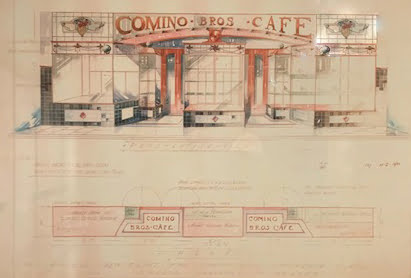Queensland Shopfitting History 1900-onwards Part 2
In 1914, World War I was declared and 57,705 Queenslanders enlisted as part of the Australian Imperial Forces. Because of the war, local wages were forced to drop by 10% to assist with the war effort. During the 1910s, changes in café design occurred which produced the layout commonly seen between the 20s and 60s. These were the detailed shopfronts with a display window, a refrigerated milk bar with pastry and confectionery counter and a dining area, with the kitchen at the rear.
In 1912, the number of oyster saloons in the city had dropped to 17, as the changeover to Greek restaurants had begun. By 1920, there were 40 Greek cafés or restaurants in Brisbane/Fortitude Valley and by 1925 there were seventy outlets. Some were fitted out with the latest Wunderlich pressed-metal ceilings, ornate timber seating cubicles, Laminex tabletops, Craftex wall panels and some in art deco design, along with beautiful brass moulding glazed shopfronts. The cafés would open early and not close until 11pm, a precursor to the modern-day McDonalds. Families would go to the Greek restaurants prior to a night out at the cinema, or to a performance at one of the Majestic Theatres and then for a nightcap afterwards. There was further growth over the next 30 years throughout Brisbane and the provincial towns. A number of these cafés survived until late into the 1970s, as they remained popular destinations for couples or families.
In Queensland, Italian restaurants did not become popular until after the Second World War. There were fewer Italian families and they did not appear to have the organisational skills for a hospitality business or political support that the Greek families had prior to this. The Italians also suffered internment during the war years, especially in Queensland. In the early years, both the Greek and Italian communities provided some fine tradespeople to our industry.
Wunderlich was a company that opened a showroom in Brisbane in 1909, selling their popular pressed-metal ceiling panels, wall linings and metal framed showcases, especially to shopfitters.In a sales brochure at the time it said, “Write for our catalogue on modern shops or send us particulars of your requirements and our representative will plan with you, special fittings that will provide protection, improve the appearance of your goods, and increase sales”.
Ernest and Alfred Wunderlich had started business in Sydney in 1893 and when their other brother Otto joined them from Europe, in 1908, they formed Wunderlich Ltd. At first, they imported their pressed-metal ceiling panels from Berlin but soon began making the ceiling panels and other shopfittings in Australia. They produced the pressed-metal panels until 1950s when they became unfashionable, however in 1983 production of the panels recommenced to meet the needs of restoration projects. Wunderlich later developed Durabestos wall sheeting and decorative interior panels, which were used by shopfitters and were manufactured at their suburban Gaythorne plant in Brisbane. They also developed and sold their aluminium shopfront/window glazing products to trade. They were eventually bought out in 1965 by Colonial Sugar Refining Co. (CSR), who were in turn bought out by James Hardie Industries.
Another well established and long-lasting company that supplied ply, veneers, timber, hardware, doors and later veneered particle board, which serviced the Fortitude Valley and the city shopfitting companies was Brown & Broad. Research shows that they commenced manufacturing at their Newstead base in 1908. They had a railway line crossing to busy lower Ann St/Breakfast Creek Road to their own railway siding well into the 1970s, much to the chagrin of traffic. Their former site is now part of the trendy apartments area opposite the Gasworks shopping precinct.
Only a couple of suburbs away in Windsor in 1912, a company that remains to this day was established: Bretts Timber and Hardware is a well-known South-East Queensland company that supplies our industry. To start with, it also had a railway siding, with timber supplied for the making of ply and other joinery products, as well as glass supplies.
Joining these elite long-standing companies, was G. James Glass in 1917, with the establishment of their original factories at The Valley and then West End. Joe Saragossi took over the helm of the company in 1958, following the death of George James, and the Saragossi family still owns and manages the successful company. In the 1970s they tried their hand at shopfitting but, from memory, this interlude did not last long.
At the end of WWI, as servicemen returned home to Australia the federal government offered those without work attendance to vocational colleges, in the hope that with some trade training it might assist them to attain employment. As they waited in the UK for transport back to Australia some were able to begin their training prior to leaving England.
In 1922, a Mr C Fraser commenced a modest small grocery store in Ann St, The Valley. This business quickly gained good patronage, so Mr Fraser conceived the idea of a self-service grocery store and in 1923 opened the original Cash and Carry store in Queen St The city. It was written at the time: “This store will be the largest and most modern self-service store in Queensland and will be fitted out in the most up to date manner. There will be a special provisions counter, where all smallgoods will be served direct from a special cooled glass room. There will be a special confectionery counter which will carry all the higher quality confectionery at the lowest possible prices. The grocery section will contain over 1000ft of display shelves, which will be stocked with quality food stuffs from all over the world.” This store opened just prior to a company in Sydney, so he was able to claim the first such system in Australia. In those days, most families still went into the city to carry out their weekly shopping.
The concept was immediately popular and grew throughout Queensland, ending up with 32 stores over the years and was one of the original anchor stores at Australia’s first shopping mall – Chermside drive-in shopping centre in 1957. Woolworths eventually purchased the 32 stores, giving them an entry into the grocery market locally.
As referred to previously, in those days, a lot of shopfitters tendered on work advertised by architects on behalf of their clients in the morning and afternoon newspapers. Some of those architectural companies are still around, having morphed into today’s well-known practices. In those days, some of the city architects also offered services such as valuing and engineering. One such architect was Lange Powell, who at that stage was in partnership with another architect named Chambers, and they traded as Chambers & Powell. Chambers was an extrovert and there is a caricature of him at a drawing board with the words “We design anything from a duck house to a skyscraper”.
Lange Powell was responsible for designing some of the well-known department stores, banks, hospitals, and retail stores in Brisbane – some that remain today. He liked to draw the retail joinery fit-outs and interiors and he was known to supervise the projects for his clients. He later joined with fellow architects Atkinson and Arnold Conrad, becoming Atkinson, Powell & Conrad. Over the years, this company morphed into the current Conrad & Gargett. In those early days, they designed stores for Woolworths and Coles; the first Woolworths was in Queen St The City in 1927. Lange Powell left this business and formed Powell Dods Thorp in 1938, which trades today as PTD Architects.
Just prior to 1920, a shopfitting company known as F H Leutchford began trading at 323 Wickham St Fortitude Valley and also had premises at 165 Edward St The City. This company was well-known across Queensland for their shopfitting prowess, especially their beautiful glass showcases with fine curved moulded brass corner glazing sections. There is a story in the Courier Mail of Friday 4th December 1936 that they had suffered a fire at their Fortitude Valley factory, but were soon up and running again, as there were ads chasing staff which appeared with regularity. They employed 60-70 staff and had their own metal shop, glass section, joinery, and paint/polish shop.
In 1939, F H Leutchford was named as the successful tenderer of large ‘extensive improvements’ to Cribb & Foote Ltd department store in Ipswich. Part of their contract was to supply and install the show window and shopfront works. The stepped shopfronts to Brisbane St. were 132 ft. long and 204 ft. long to the Bell St frontage, so quite a large contract. The company was purchased in 1977 by Silverwood and Beck and then traded as Silverwood & Beck Leutchford at Eagle Farm until closure in1985. With the demise of Silverwood & Beck Leutchford, John Cole, who was general manager at the time, along with Ron Cummins and other previous staff members, established Action Shopfitters at Eagle Farm in 1986. This was a successful shopfitting company which traded until 2020.
Another successful shopfitting company that commenced in the late 1920s was Taylor Christie & Walker. Their office and factory was at 14 Ross St Newstead. They later changed their name to Christie and Walker Pty Ltd. They were a well-known and respected company, which traded until purchased by Robb and Brown Shopfitting Industries in the 1950s. They also carried out in-house designs back in those days. Christie and Walker employed many apprentices over the years, many of whom later became well known with their own shopfitting companies.
Another business that was long-lasting and, at one stage, had 33 employees, was Brooks Joinery at 270 Gympie Rd Kedron. The two brothers, Les and Maurice Brooks, commenced as a partnership in 1927. Les had served his apprenticeship with the renowned Ed Rosenstengel at his Fortitude Valley factory, and Maurice at Norman Wrights Shipyards at Bulimba. In 1933, Brooks Joinery was established and the business prospered through the depression years and soon they commenced selling hardware as well to nearby industries.
At the start of World War II, their factory was declared a protected undertaking, so they changed their manufacturing to wartime needs, making work barges, motor rescue launches and bomb scows for the defence forces (Maurice’s boat building skills would have come in very handy). Les and Maurice dissolved their partnership in 1948, with Maurice continuing the joinery business and Les a separate, expanded hardware business, which traded until 1983. Keith Jesberg was manager when Brooks joinery closed down in 1968, and in 1970 he commenced Allkind Joinery at Rode Rd, Chermside, which is a successful business to this day, supplying quality joinery and retail cabinetry, office and bar works.


Leave a Reply
Want to join the discussion?Feel free to contribute!